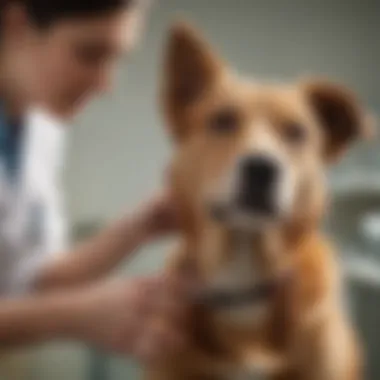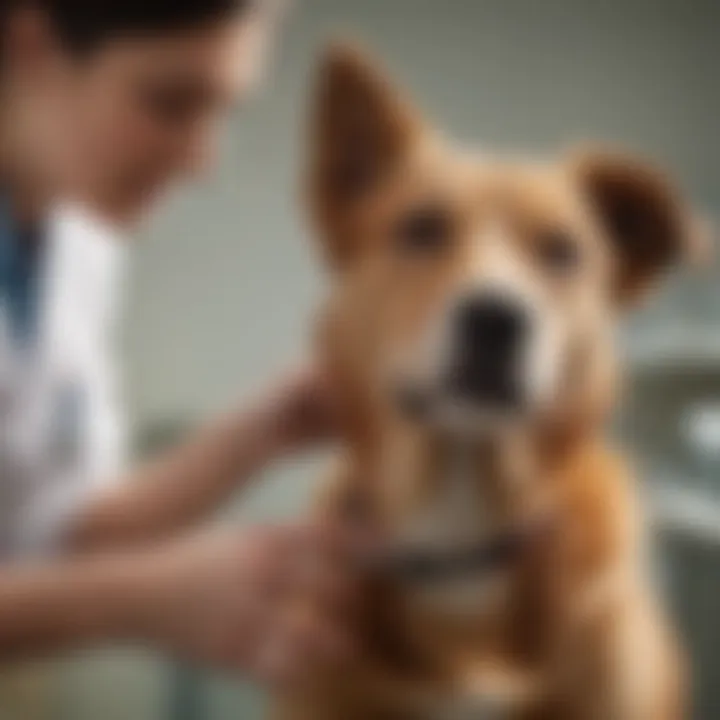Understanding Dog Panting and Diarrhea: Key Insights


Intro
When it comes to our furry companions, understanding their behavior is crucial, especially when something seems off. Dog panting and diarrhea can be alarming signs to pet owners, and getting a grasp on what these symptoms mean can be a real game changer. Not only do they reflect a dog's physical state, but they also hint at possible underlying health issues that need our attention.
In this article, we're diving into the causes of dog panting and diarrhea, the implications on overall health, and the appropriate actions pet owners should consider to ensure their beloved companions remain in tip-top shape.
Both panting and diarrhea can arise from a variety of factors that range from environmental influences such as the weather to more serious health complications. For pet owners, recognizing the patterns and understanding what causes these symptoms can enhance their ability to respond effectively, ensuring that their dog receives the needed care promptly.
Educating ourselves about these signs not only helps in fostering a deeper bond with our pets but also empowers us to make informed decisions about their health. Let's embark on this journey of understanding.
Prologue to Dog Panting and Diarrhea
When discussing the health and well-being of dogs, one often overlooked aspect is their bodily signals, particularly panting and diarrhea. Understanding these symptoms is crucial for pet owners, as they can indicate underlying health issues. Recognizing the difference between normal and excessive panting, or identifying the type of diarrhea your dog might be experiencing, can be a game-changer in ensuring your pet’s comfort and longevity.
Importance of Understanding These Symptoms
Every dog owner should pay attention to how their pet communicates through behavior and physiological responses. Panting, for example, isn't just a sign of heat or excitement; it can also signal stress, pain, or potential health complications. On the flip side, diarrhea, while often dismissed as a minor inconvenience, can lead to serious health risks if left unchecked. Both symptoms are intertwined and often arise from similar triggers.
The significance of understanding these symptoms cannot be overstated. It empowers dog owners to react promptly to potential health problems and to foster a well-informed approach to pet care. This knowledge can make a difference between a simple fix at home and a costly intervention at the vet.
"Knowing when your dog is in distress is half the battle; responding appropriately is the rest."
Key Elements to Consider
- Recognition of Symptoms
Being able to spot abnormal behavior is the first step. Owners should familiarize themselves with what panting and diarrhea commonly look like in their dogs. - Underlying Causes
Both panting and diarrhea can result from various factors including environmental stressors, health conditions, or behavioral issues. Understanding the root can guide better treatment and preventative strategies. - Response Mechanisms
Knowing the right actions to take when encountering these symptoms could prevent escalated health issues. In many cases, simple dietary adjustments or changes in routine can have positive effects. - Veterinary Guidance
There is a time for self-care and a time to seek professional help. Understanding when to involve a veterinarian is crucial for ensuring your dog receives the best care possible.
Ultimately, seeking to understand dog panting and diarrhea is not merely about addressing discomfort; it’s about building a deeper bond with our furry friends through attentive care and timely responses. As we navigate through this article, we will delve deeper into the causes, implications, and actions related to these significant symptoms.
Understanding Dog Panting
Understanding dog panting is crucial for pet owners and animal lovers alike. Panting is a normal behavior in dogs, but it can signal various underlying conditions. Knowledge of this phenomenon allows owners to differentiate between normal and concerning situations. If you see your dog panting heavily, it’s not always a straightforward case of needing to cool down; it can indicate stress, discomfort, or even health issues. By recognizing these cues, pet owners can better support their furry companions, enhancing not only their physical well-being but also their emotional state.
Physiological Mechanisms Behind Panting
Panting is primarily a mechanism for thermoregulation in dogs. Dogs lack the ability to sweat like humans do, so they rely on panting to dissipate body heat. When a dog pants, breathing rates increase, helping to cool the body down as moisture in the lungs evaporates. This process is managed by the brain’s hypothalamus, which detects internal temperature changes. Excessive panting, however, can indicate other issues. It's worth mentioning that other problems like pain or anxiety can interfere, complicating the physiological response.
Normal vs. Excessive Panting
To understand panting, it’s essential to distinguish between what is normal and what is not. Normal panting occurs in situations like exercise or hot weather. Here’s a breakdown:
- Normal Panting: Characterized by a steady rate and less intense effort. It typically arises after physical exertion or exposure to warmth. In these situations, a chill factor may also alleviate panting.
- Excessive Panting: This type includes heavy and prolonged panting not linked to temperature change or activity. This might be a cause for concern, as it could point to anxiety, pain, or a serious medical condition. It’s always wise to observe your dog's behavior to discern any drastic changes.
Common Causes of Panting
Heat
Heat is among the leading causes of panting in dogs. When temperatures rise, dogs need to cool down, making panting an effective response. The key characteristic of heat-induced panting is that it usually lessens when the temperature drops or the dog is moved to a cooler space. However, there's a drawback. Prolonged exposure to high temperatures can lead to heat exhaustion or heatstroke, which can be fatal if not addressed swiftly. Hence, being aware of your dog’s condition in warm weather is essential.
Anxiety
Anxiety in dogs is another notable contributor to panting. Situations like thunderstorms, fireworks, or changes in routine can trigger anxiety responses. Dogs tend to pant when anxious, which can escalate stress. The startling characteristic of anxiety is that it often correlates with other signals like whining or a tucked tail. Understanding anxiety-driven panting is crucial, as it reveals an emotional state that necessitates intervention. However, the flip side is that addressing this anxiety through training and a calm environment can lead to marked improvement for your dog.
Pain
Pain is a significant factor that can lead to panting. Dogs, being naturally stoic creatures, often disguise their discomfort until it becomes evident. Panting coupled with other signs such as whining or reluctance to move can indicate pain. The essential point here is that pain-induced panting is often an urgent call for attention. Should panting occur alongside decreased appetite or abnormal behavior, it demands immediate examination. Each case is unique, and recognizing pain signals can help ensure timely veterinary care.
Health Conditions
Various health conditions can lead to abnormal panting. Heart disease, respiratory issues, and infections might be underlying culprits. The distinctive feature of health-related panting is that it often persists even in calm environments. These issues highlight the significance of routine check-ups, as early detection can prevent complications. The tricky part is that many pets may not show clear signs until they become severe, but vigilant monitoring of your dog’s breathing patterns can enable timely action.
Diarrhea in Dogs: An Overview
Diarrhea in dogs can be more than a mere inconvenience; it is often a signal that something demands attention. Understanding the varied aspects of diarrhea helps pet owners grasp the full scope of potential issues that might arise. Diagnostics can range from benign to severe, and recognizing them keeps your dog on the road to recovery. In this section, we will explore types of diarrhea and how to identify symptoms, which contributes to a broader understanding of your pet's health.
Types of Diarrhea
Different types of diarrhea manifest in dogs, each with its own origins and implications, which is important for diagnosing the underlying causes. Knowing these types helps pet owners differentiate between what's urgent and what's not.
Acute Diarrhea
Acute diarrhea generally appears suddenly and may last just a day or two. This type is often linked to dietary indiscretion—think of Fido sneaking a few too many scraps from the table. The key characteristic here is its sudden onset
and relatively short duration, which makes it a common topic in health discussions among dog owners. Its unique feature is often tied to gastrointestinal upset from abrupt changes in diet or exposure to new food. While it may self-resolve, ignoring it can lead to complications, so it's crucial to monitor your dog's eating habits.
Chronic Diarrhea
Chronic diarrhea, on the other hand, is a persistent condition that can last for weeks or even months. This type stems from underlying health issues, such as food allergies or gastrointestinal disorders. A key characteristic of chronic diarrhea is its long-lasting nature, demanding a more serious approach to diagnosis. Its unique feature is this protraction, which could involve repeated vet visits and treatments. While managing chronic diarrhea can be a lengthy process, understanding what triggers it can lead to effective management.
Non-infectious Diarrhea


Non-infectious diarrhea is caused by factors that do not involve pathogens, ranging from allergies to toxins. This type brings attention to the dietary aspects or environmental triggers affecting your dog's health. The key characteristic of non-infectious diarrhea is its dependence on the individual dog's diet and surroundings, emphasizing the vital role of careful ingredient selection in dog food. Its unique feature is that it can often be prevented. Education about what is in your dog's food can lead to fewer incidents of this type of diarrhea.
Infectious Diarrhea
Infectious diarrhea involves pathogens, such as viruses or bacteria, and thus can be highly contagious. The key characteristic of infectious diarrhea is its infectious nature, which often leads to outbreaks in multi-pet households. What makes infectious diarrhea so treacherous is its potential for severe dehydration and systemic effects that require urgent attention. Understanding its signs is crucial because prompt medical intervention can significantly affect your dog's prognosis.
Identifying Symptoms of Diarrhea
Recognizing the symptoms of diarrhea extends beyond just noticing the loose stool. Pet owners must be keen observers, catching telltale signs that can guide their approach.
Consistency of Stool
The consistency of a dog's stool is paramount in assessing diarrhea. For instance, watery or very soft stools are indicators of an urgent problem. The unique feature here is that the consistency can reveal a lot about the dog's overall health. A firm bowel movement often signals a well-functioning digestive system. Understanding this can help you make informed decisions, whether it's providing a bland diet for recovery or consulting a vet for further examination.
Frequency of Bowel Movements
The frequency of bowel movements is also a significant marker. An increase in the number of times a dog poops can signal trouble, especially when coupled with any changes in behavior. Instead of focusing only on the mess, observe how often your dog seems to have the urge. This unique feature plays a critical role in gauging the severity of diarrhea—more frequent trips to relieve themselves typically indicate that something is amiss.
Presence of Blood or Mucus
Finally, any presence of blood or mucus within the stool should raise immediate red flags. This key characteristic signals potential issues that can range from moderate to severe, necessitating quick action. The unique feature here is that blood or mucus could indicate infections or irritations in the gastrointestinal tract, calling for an urgent consultation with a veterinary professional. Awareness of these signs can help you act swiftly, possibly saving your dog from a more serious condition.
Ultimately, awareness of these aspects of diarrhea enables better decision-making and prepares you for what steps to take next.
The Relationship Between Panting and Diarrhea
Understanding the connection between panting and diarrhea in dogs is crucial for pet owners. While these symptoms may appear unrelated at first glance, they can often arise from common underlying issues.
This section explores the physiological connections between these two responses, the stress factors that may amplify them, and the key considerations pet owners should be aware of when these symptoms occur simultaneously.
Physiological Connections
When a dog pants, it usually acts as a mechanism for regulating body temperature or responding to stress. Like humans, dogs also have physiological stress responses, which can result in various symptoms such as rapid breathing. On the other hand, diarrhea signifies a disturbance in the gastrointestinal system.
Both symptoms may be the body’s way of signaling distress. For instance, if a dog is overheated from excessive panting, it could also lead to nausea or upset stomach, ultimately causing diarrhea. The interconnectedness highlights how often these symptoms stem from a single issue. Moreover, health conditions, such as infections or inflammation, can provoke both panting and digestive disturbances at once.
Stress as a Common Factor
Stress is like a double-edged sword for our furry companions. Dogs can experience stress due to changes in environment, loud noises, or even separation anxiety. When stressed, it’s not unusual for a dog to start panting and, in some cases, develop diarrhea.
Several indicators can help identify stress in a dog:
- Laying low: Dogs may try to hide during stressful situations.
- Excessive grooming: This can be a manner of self-soothing.
- Changes in appetite: Reduced interest in food often accompanies stress.
If a dog pants heavily and has loose stools on the same day, pet owners should examine the dog's environment for stressors. Immediate action could relieve both the panting and the digestive upset, leading to a calmer, healthier pet.
When Panting Accompanies Diarrhea: Key Considerations
When both symptoms emerge together, the stakes can be higher. For one, it could indicate that the underlying cause may need more immediate attention. Here are critical aspects to consider:
- Duration of Symptoms: If both symptoms persist beyond a short period, it’s essential to assess the situation.
- Severity of Diarrhea: The presence of blood or extreme frequency could signal a more acute issue.
- Overall Behavior: Is your dog lethargic? Is there a notable change in their personality? This can signify something beyond mild discomfort.
In situations like these, it’s always prudent to consult a veterinarian. They can provide insights that are beyond just observation, helping to determine if medical intervention is necessary.
"Understanding the connection between symptoms is crucial to ensure your pet receives timely care."
Environmental Factors Influencing Symptoms
When exploring the world of dog panting and diarrhea, it’s essential to consider how the environment plays a pivotal role in these symptoms. Environmental factors can have a significant impact on a dog’s physical well-being, stirring symptoms like excessive panting or gastrointestinal distress. Pet owners should recognize these influences to better understand their furry friends’ needs and to take preventive measures. Let’s delve into specific facets of these environmental influences.
Weather Conditions
Weather undeniably affects our canine companions. Extreme heat can lead dogs to pant excessively as they attempt to cool down since they don’t sweat like humans. This is particularly evident during scorching summer months or in humid climates. It is vital to be aware of a dog’s response to heat, especially breeds with shorter snouts, such as Bulldogs or Pugs, which are more prone to overheating.
- Signs of heat stress: Common indicators include heavy panting, drooling, and a frantic need for water.
- Precautionary steps: During hot days, it’s advisable to keep dogs indoors during peak sun hours and ensure they have access to shade and fresh water when outside.
Conversely, cold weather can also lead to discomfort. Dogs may shiver and seek warmth, and in some cases, that stress can manifest as panting. Providing a comfortable environment is essential to their overall health.
Dietary Changes
Dietary modifications can drastically affect a dog’s digestive system, leading to diarrhea. This might stem from sudden changes in their food brand, the introduction of new treats, or even inappropriate snacks that don’t sit well with their stomachs.
- Common dietary disruptors:
- Sudden food changes
- Human food scraps
- Low-quality ingredients
A gradual transition when changing diets is crucial. Ideally, pet owners should blend the new food with the old over several days to give a dog’s digestive system time to adjust. Furthermore, keeping track of what dogs eat can help identify potential allergens or irritants in their diet, fostering better eating habits and, ultimately, improved health.


Exposure to Toxins
The environment can be littered with potential toxins that impact our canine friends significantly. Many household items or outdoor plants can be hazardous, causing reactions that lead to both panting and diarrhea. Common sources to beware of include:
- Household cleaning agents: Many contain chemicals that are harmful to dogs. Keeping these products out of reach is imperative.
- Plants and flowers: Some common plants are toxic to dogs. Examples include lilies and azaleas, which can cause gastrointestinal issues.
- Pesticides and fertilizers: These chemicals, while effective for household and garden upkeep, can pose serious health threats to dogs if ingested or inhaled.
"Keeping your dog away from potential toxins is not just about prevention; it’s about safeguarding their health and happiness."
Awareness and prevention are critical. It’s advisable for pet owners to educate themselves on potentially harmful substances in their vicinity and make necessary adjustments to their homes and gardens for the safety of their pets. Each of these factors contributes to a comprehensive picture of a dog’s health, with panting and diarrhea often being telltale signals that the environment is influencing their well-being.
Health Implications of Panting and Diarrhea
Understanding the health implications of panting and diarrhea in dogs is a vital aspect for any pet owner. While these symptoms can sometimes seem benign or simply annoying, they can point to deeper health issues that should not be ignored. Recognizing the potential health risks is crucial not only for the immediate well-being of your pet but also for preventing long-term health problems.
Dogs use panting as a natural mechanism to regulate body temperature and cool down. However, excessive panting can be a red flag indicating anxiety, pain, or even serious health conditions. In contrast, diarrhea is more than just an inconvenience; it can lead to dehydration and nutrient loss, which can have significant repercussions on your dog's health.
By paying attention to these signs, you empower yourself to take action at the right time, ensuring your pet remains healthy and happy.
Potential Health Risks
It is important to understand how panting and diarrhea can be symptoms of underlying health issues. Here are some potential risks:
- Respiratory Issues: Excessive panting may be a signal of lung disease or other respiratory conditions. Problems like pneumonia may lead to increased panting as the dog struggles to intake oxygen.
- Cardiovascular Problems: An elevated heart rate can often accompany panting. Heart conditions can cause your dog's body to compensate by breathing heavier.
- Gastrointestinal Problems: Diarrhea can range from mild to severe, often pointing to intestinal disorders, parasites, or even tumors in serious cases. Continuous diarrhea may indicate a more systemic issue at play.
- Infectious Diseases: Certain infectious diseases can present both panting and diarrhea as symptoms, leading to severe dehydration and other complications.
Understanding Dehydration Risks
When a dog experiences diarrhea, hydration becomes a pressing concern. Dehydration can develop quickly, especially in cases of acute diarrhea. Here’s what to know:
- Fluid Loss: Diarrhea can cause your dog to lose more fluids than they can replenish. This situation may result in symptoms like dry gums, excessive thirst, and lethargy.
- Electrolyte Imbalance: Along with fluid loss, essential electrolytes such as sodium and potassium can also be expelled during diarrhea, affecting your dog's heart and muscle function.
- Symptoms of Dehydration: Monitor for signs such as a decreased frequency of urination, increased heart rate, or loss of skin elasticity, which is noticeable when you briefly pull up on the skin at the back of the neck.
Signs of Severe Illness
A responsible pet owner should always be vigilant for signs indicating that a dog's condition might be severe. If your dog exhibits the following signs alongside panting or diarrhea, seeking veterinary assistance is paramount:
- Persistent Vomiting: Coupling vomiting with diarrhea can signal a more serious condition.
- Lethargy: A sudden change in energy levels means it’s time to take action.
- Bloody Stools: Blood or unusual coloration in stools should never be overlooked.
- Difficulty Breathing: Struggling to breathe or labored breathing is an immediate red flag that requires urgent attention.
"An ounce of prevention is worth a pound of cure."
Investing time and effort in understanding these symptoms can mean preserving your dog's quality of life. Consult regularly with your veterinarian and keep an eye out for any changes in your pet’s behavior or health.
Immediate Actions for Pet Owners
When it comes to the health and wellbeing of our furry friends, understanding the immediate actions to take in case of panting and diarrhea can make all the difference. Dogs can show us their discomfort in various ways, and it is up to us as responsible pet owners to decipher these signs and respond appropriately. The importance of being vigilant and proactive cannot be overstated; timely actions can often be the difference between a minor issue and a serious health crisis.
Monitoring Symptoms
Monitoring your dog's symptoms is the first step in managing potential health issues related to panting and diarrhea. Pay close attention to the frequency and severity of these symptoms. Every dog is unique, and their normal behavior may vary. Thus, what may seem normal for one dog can actually indicate trouble for another.
- Keep an eye on the duration: If your dog pants excessively or has diarrhea lasting more than a day, it warrants a closer look.
- Assess their overall demeanor: Is your dog drinking less water, or appearing lethargic? Notice any changes in their playfulness or energy levels.
- Check for additional symptoms: Look out for signs like vomiting, excessive drooling, or unusual vocalizations; these could indicate a deeper issue.
Using a symptom diary can be beneficial. Jot down times, behaviors, and any dietary changes. This information helps your vet quickly form a diagnosis if needed.
Dietary Adjustments
Making dietary adjustments can significantly aid recovery if your dog is experiencing diarrhea. What goes into their bowl can sometimes soothe an upset stomach or minimize gastrointestinal distress. Here are a few considerations:
- Withhold food for a short period: This can give your dog’s digestive system a break. Generally, fasting for 12-24 hours is often advised, but always ensure they have access to fresh water.
- Introduce a bland diet: After the fasting period, you could gradually introduce bland foods such as boiled chicken (without skin) and plain rice. These are gentle on the stomach and can help firm up stools.
- Monitor their reaction: Each dog responds differently, so observe how they handle the new food. If diarrhea persists, you might need to consult your vet for advanced dietary recommendations or possible snacks that can help.
Hydration Strategies
Hydration is crucial, especially when a dog is experiencing diarrhea, as it can lead to quick dehydration. Dogs need to keep their fluids up to flush out toxins and support recovery. Here are some practical steps to ensure your dog stays hydrated:
- Provide fresh water at all times: Ensure your pet has constant access to clean, fresh water. If they are reluctant to drink, try offering ice cubes or flavored (low-sodium) broths to encourage them.
- Consider electrolyte solutions: You can also ask a vet about electrolyte solutions specifically formulated for dogs. These can help replenish lost fluids and nutrients.
- Monitor urination: Pay attention to how often your dog is urinating. A marked decrease could indicate dehydration, and it's best to consult a vet if this occurs.
Remember: By keeping a close watch on symptoms, tweaking the diet as necessary, and ensuring proper hydration, you can effectively help your dog through a challenging time. Always err on the side of caution and don’t hesitate to contact your veterinarian if you have any concerns about your dog's health.
When to Seek Veterinary Attention
Recognizing when a trip to the vet is needed can make a world of difference for your dog’s health. While the symptoms of panting and diarrhea might seem mild at first, they can sometimes indicate more serious underlying issues. Ignoring these warning signals can lead to complications that may affect your pet's wellbeing, necessitating a more complex treatment later on.
First off, let's touch on some specific elements that should raise red flags. If your dog is panting excessively and it’s accompanied by diarrhea, this is not a situation to take lightly. The combination of these symptoms often points to stress or discomfort, potentially signaling heat exhaustion, poisoning, or other medical emergencies.
Moreover, consider the duration of these symptoms. Persistent panting and diarrhea, especially when combined with other symptoms, should prompt immediate action. It’s imperative to trust your instincts as a pet owner; if something feels off, it likely is.
Benefits of Seeking Timely Veterinary Care
- Early Diagnosis: Timely intervention often leads to quicker diagnosis and treatment, preventing minor issues from becoming major problems.
- Peace of Mind: Knowing your pet is being cared for by a professional can alleviate your own anxieties, allowing you to focus on helping your dog recover.
- Proper Treatment: A veterinarian can better assess the situation, conducting any necessary tests and prescribing the appropriate medications or dietary changes.


Taking action promptly ensures your furry friend gets back to their playful self as fast as possible.
Considerations for Veterinary Visits
- How severe are the symptoms?
- Has anything changed recently in their diet or environment?
- Are there any other symptoms present, such as lethargy or vomiting?
Monitoring your dog attentively can commonly highlight health changes that might require professional expertise.
Culmination
Before the situation escalates, being proactive in seeking veterinary attention when necessary strengthens the bond you share with your pet. Your attentiveness is key in ensuring they lead a healthy, happy life.
Recognizing Warning Signs
One of the challenges every dog owner faces is recognizing the clear and sometimes subtle signs that indicate a need for veterinary care. Knowing what these signs are can be the difference between a quick recovery and a complicated health issue.
First, look for excessive panting. While dogs do pant, especially after exercise or in high heat, a sudden increase accompanied by other symptoms like restlessness or pacing can reveal a deeper concern.
Furthermore, diarrhea can be a symptom of numerous conditions, from dietary indiscretion to infections. Here are some specific elements to watch out for:
- Unusual Consistency of Stool: Watery, mucousy, or bloody stools signal urgency.
- Increased Frequency: More than three bowel movements in a day could be a cause for concern.
- Accompanying Symptoms: Vomiting, lethargy, or loss of appetite can indicate a more serious condition.
It's crucial that if any of these signs are observed, it's better to be safe than sorry. The quicker you act, the better the chances for treatment success.
Preparing for the Vet Visit
Once you've determined that a vet visit is needed, preparation can enhance the experience and ensure all concerns are addressed.
Start by documenting your dog's symptoms in detail. Include notes on:
- Duration of Symptoms: How long has the panting or diarrhea been occuring?
- Dietary Changes: Have you introduced any new food or treats recently?
- Behavior Changes: Any lethargy or altered behavior that has caught your attention?
Feeding your dog a small amount of easily digestible food, if they can keep it down, might help to stabilize their system before the visit.
When you arrive, bring your dog's medical records if possible, including vaccination status, and any medications they are currently taking. This information assists your veterinarian in managing overall health and tailoring treatment. Remember, a well-prepared pet parent can make all the difference.
With preparation and awareness, you can ensure that your dog receives prompt and effective care, paving the way toward a swift recovery.
Preventive Measures for Healthy Pets
Preventive care for dogs is the backbone of a healthy, happy life for your furry companions. Just like humans, dogs can benefit immensely from taking proactive steps to ensure their well-being. There’s no use waiting for a problem to rear its ugly head when you can tackle potential issues before they bloom.
Routine Health Checks
Regular health check-ups are a cornerstone of any preventive care strategy. These exams help spot health concerns that might not be obvious at first glance. For instance, subtle changes in behavior or physical condition can signal an underlying issue.
- Why It's Important: Consistent veterinary visits pave the way for early diagnosis of conditions. Catching health problems early often leads to better treatment outcomes. Dogs can’t exactly tell us when somethings up. Therefore, these check-ups become vital.
- What to Expect: During a routine check, your vet will likely perform a physical examination, check the dog’s weight, and possibly run blood tests or other diagnostics depending on age and health history.
Maintaining a Balanced Diet
Nutrition plays a crucial role in preventing health issues such as obesity, diabetes, and gastrointestinal problems. When we talk about a balanced diet, we’re essentially discussing a mix of high-quality proteins, healthy fats, and necessary vitamins and minerals.
- Real Food Matters: What we feed our dogs should be suitable for their life stage—puppy, adult, or senior. It's essential that you watch the calories too. Overfeeding can lead to weight issues that set the stage for further complications.
- Special Considerations: Some dogs may have specific dietary needs due to allergies or health conditions. Consult your veterinarian to curate a nutrition plan that caters to your dog's specific needs.
Stress Management Techniques
Just like humans, dogs can suffer from stress and anxiety, which can ripple into their physical health. Being able to manage your dog's stress levels effectively is key to maintaining their overall health.
- Recognize your Dog’s Cues: Dogs may pant, pace, or hide when stressed. By paying close attention to these signals, you can intervene before anxiety becomes a larger issue.
- Techniques to Incorporate: Simple changes such as providing a safe space, maintaining a routine, and using calming supplements can help ease their worries. Engaging in activities like daily walks, interactive play, or even canine yoga can work wonders for their mental well-being.
"An ounce of prevention is worth a pound of cure." Keeping a close eye on your dog's health through these preventive measures can save you heartache and vet bills down the line.
Culmination: Understanding Canine Signals
In the world of pet ownership, understanding the signals given by our canine companions is crucial. This insight transcends mere observation; it forms the bedrock of responsible pet care and enhances the human-animal bond. Dogs communicate primarily through body language and, at times, vocalizations. Recognizing these signals is essential not just for responding to their needs but also for ensuring their overall wellbeing.
Focusing on the relationship between panting and diarrhea, it’s vital to discern what these symptoms may indicate about a dog's health. For instance, panting in scenarios where it's unexpected can hint at stress or discomfort, while diarrhea can be a sign of dietary issues or illness. Both symptoms, when understood properly, can lead to timely interventions that could save a dog from further distress.
Consider the broader implications: a dog that is showing signs of anxiety or suffering from gastrointestinal distress needs a sensitive owner who can act swiftly. This can mean the difference between a routine vet visit or a more serious health crisis. The depth of understanding a pet owner cultivates can determine the quality of life for their furry loved one.
Building a Stronger Bond Through Awareness
Awareness goes beyond knowing when your dog is simply in need of food or exercise. It involves observing day-to-day nuances that might signal discomfort or illness. When pet owners invest time in understanding their dog's unique behaviors and signals, they are not just identifying needs; they are fostering trust and enhancing their bond.
Taking note of how your dog pants when excited or anxious can shift your approach to training and handling. Likewise, understanding the meaning behind certain bowel habits can inform dietary adjustments or veterinary consultations.
Here are several actions pet owners can take to build this awareness:
- Regular Observations: Spend time watching for changes in behavior, such as changes in eating, drinking, or the way they move.
- Documenting Symptoms: Keep a health journal. This can include instances of panting coupled with diarrhea and any environmental changes that accompanied them.
- Education: Read up on canine health and behavior. The more you know, the better prepared you will be.
- Engage with Communities: Online forums or local dog groups often provide support and shared experiences, which can be enlightening.
"Understanding your dog's behavior opens up channels for better communication. It’s that simple yet profound connection that makes pet ownership so rewarding."
A well-informed owner becomes an advocate for their dog, ready to engage with veterinary professionals as necessary. Thus, by fostering an environment where knowledge and empathy coexist, one nurtures a resilient relationship, helping ensure that both the dog's and owner's needs are met. This not only leads to a healthier pet but also to a fulfilling companionship that thrives on understanding.



